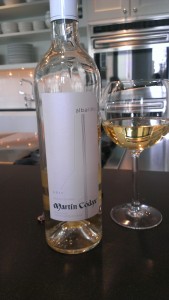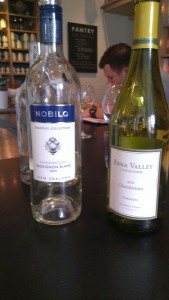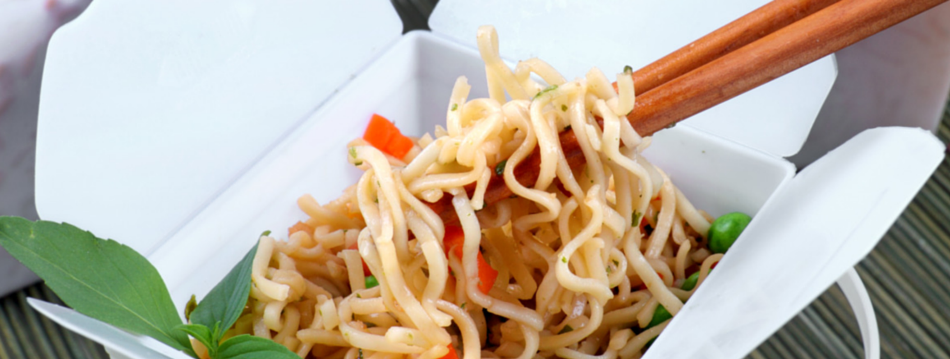.jpg) In culinary school the longest class we took was a class called Wines and Menus. It was really two classes, and if you were lucky (and I was) you had menus in the morning and wines in the afternoon. We met five days a week, working in small teams to create a plan for a restaurant including menus, choosing china, linens, designing both the dining room and kitchen, and of course creating a wine list. The wines class was just what you’d expect, five days a week for two hours a day, for six weeks we tasted wine. We learned about the various wine producing regions throughout the world, types of glassware, opening and pouring techniques, and tasted a lot of wine. It wasn’t all a lark; the tasting part of course was easy, but the tests were grueling.
In culinary school the longest class we took was a class called Wines and Menus. It was really two classes, and if you were lucky (and I was) you had menus in the morning and wines in the afternoon. We met five days a week, working in small teams to create a plan for a restaurant including menus, choosing china, linens, designing both the dining room and kitchen, and of course creating a wine list. The wines class was just what you’d expect, five days a week for two hours a day, for six weeks we tasted wine. We learned about the various wine producing regions throughout the world, types of glassware, opening and pouring techniques, and tasted a lot of wine. It wasn’t all a lark; the tasting part of course was easy, but the tests were grueling.
In general, it was as much fun as it sounds, and the local liquor store did their homework and stocked many of the wines we tasted, so we would roll on down and buy the things we loved and could afford. I lived in a house with three other students and we were all hooked on Brachetto, a red sparkling wine from Italy, drinking it like soda, and acting as if we had discovered it. We tasted wines from all over the globe, mostly quite good, and way out of my price range, both then and now…
This week I took another wines class, this one with Brian Freedman. In this class (which lasted two hours, not six weeks) we tasted seven wines. All the wines we tried were in the $15.00 range, and all were good solid representatives of their style. For a tasting one goes from lightest to heaviest, so we started with a sparkling white and ended with a cabernet sauvignon.
The Piper-Sonoma sparkling wine we tasted was from California, and made in the traditional Champagne method, which is an elaborate and labor intensive process, though the process isn’t enough for a sparkling wine to be designated Champagne. Champagne is only produced in the Champagne region of France, and though many other countries—including the United States produce excellent sparkling wines none of them are true Champagne. We also got a lesson in opening the bottle, and I learned some new tricks: leave the cage on the bottle (though loosened) and remove it with the cork, turn the bottle, not the cork, and as soon as you feel the cork starting to pop, try to push it back into the bottle (which you will not be able to do). Never point the bottle away from you and press with both your thumbs! (I did know that.) When opening sparkling wine the sound should be a whisper, not a POP.
We had three more white wines; Nobilo, a sauvignon blanc from New Zealand; a light fruity wine perfect to pair with flavors of basil and tarragon. Brian cautioned us that when pairing food and wine the weight of the wine should match the weight of the food, and that the wine should never be sweeter than the food it is paired with. The next wine was an oak barreled chardonnay from the central coast of California, and we talked about malolactic fermentation which is a process that reduces the harsh malic acid in wine and converts it to the softer lactic acid, giving the wine a soft, lush quality. The last white wine was from a grape I had never heard of, Alberinio from Galicia in the northwest corner of Spain just north of Portugal. I particularly liked this wine, it would be great with Thai, Szechuan or Mexican food (provided the Mexican food is the non-cheesy sort).


We started with a red Simi pinot noir. Pinot noirs are lighter and softer than cabernet sauvignon, slighly less tannic, and light enough to pair with a roast chicken, or leaner pork and lamb. Up next was a Chianti which is another varietal that only comes from Chianti in Italy. Chianti must be at least 75% sangiovese grapes, and like most Italian wines is meant to be consumed with food, not on its own. It is a perfect wine for a spaghetti and meatball or lasagna dinner as the tannins will balance the fat and proteins of the food. For the big finish we enjoyed a Ravens Wood cabernet sauvignon. Cabernets are big wines, heavy and robust enough to stand up to a thick , fatty rib eye or a rich roast beef dinner complete with Yorkshire pudding.
There is not enough space here, for me to include everything Brian taught us. I’m sure I’ll refer to this class again as time goes on, but for now, I urge you to try some new wines, and some new combinations. When you make your choice think about balancing the flavors in the wine with the flavors of your food, to enhance both. If you think your dish would benefit from some citrus flavors why not add it in your glass with some Chablis?





.jpg)




